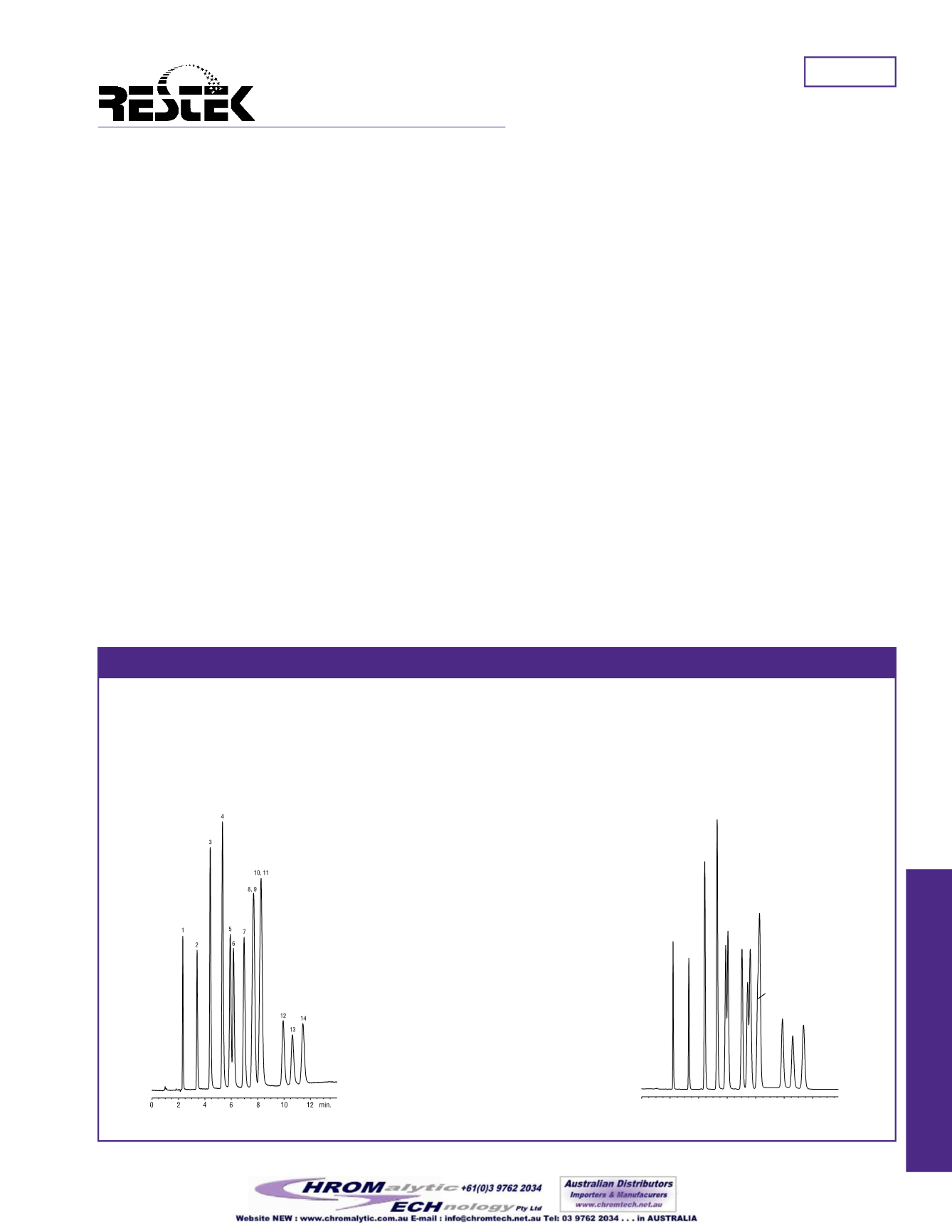
HPLC
Applications
note
Restek Corporation • (800) 356-1688 • (814) 353-1300 •
#59361
HPLC
HPLCAnalysis ofTrace-Level ExplosivesUsingPinnacle II
™
C18 andCyano
Columns
Figure 1
The newPinnacle II
™
C18 column achieves slightly better resolution for difficult to analyze pairs of explosive compounds.
Selectivity for the 14 explosives of interest listed inMethod
8330Aare similar on the original Pinnacle
™
and the new
Pinnacle II
™
C18 columns (Figure 1). On theseC18 columns,
there are close-eluting peaks or coelutions for the following
compounds: tetryl/nitrobenzene; 2-amino-4,6-dinitrotoluene/4-
amino-2,6-dinitrotoluene; and 2,6- dinitrotoluene/2,4dinitro-
toluene. Closer examination shows that the newPinnacle II
™
C18 column achieves slightly better resolution for several of
these pairs. Thismay be caused by the slightly higher surface
area and carbon load, and the smaller pore volume on the
Pinnacle II
™
column (110Å) as compared to the Pinnacle
™
col-
umn (120Å). The higher carbon load of 13% for the Pinnacle
II
™
column versus 11% for the Pinnacle
™
column translates into
longer compound retention, better resolution, and column life-
time.
According toMethod 8330A, these 14 compounds also need to
be analyzed on aCyano column for confirmation (Figure 2).
The change from the reversed phaseC18 column to the normal
phaseCyano column is fairly easy. Themethod recommends
using the samemobile phase for both columns, which allows a
quick changeover from the primary analysis to the confirmation
analysis. Because themobile phase is a simplemixture of water
Pinnacle II
™
high performance liquid chromatography (HPLC)
stationary phaseswere designed to functionwell under the dif-
ficult matrices encountered in environmental samples. The orig-
inal Pinnacle
™
columns served as benchmarks for the selectivity
and efficiency of the newPinnacle II
™
columns.While striving
to create new columnswith characteristics similar to Pinnacle
™
columns, Restek also designed themanufacturing process in
such away that they could be priced economically. Using
Restek silica, we can go a step further in providing consistent
quality and reproducibility.
The newPinnacle II
™
C18 andCyano columns function as pri-
mary and confirmation columns (respectively) to efficiently
separate explosives according toUSEnvironmental Protection
Agency (EPA)Method 8330A. Environmental methods fre-
quently employ a confirmation column for two reasons. First,
many environmental methods require scanning for a large num-
ber of related compounds. Because of their similarities, analysts
oftenwill encounter coelutionswhen using a single type of sta-
tionary phase. Second, thematrices encountered inmany envi-
ronmental samples can contain components that may interfere
or obscure the analytes of interest. By using two columnswith
different selectivities, analysts canmore accurately identify the
analytes of interest.
1
2
3
4
5
6
7
8
9
10
11
12
13
0
2
4
6
8
10
12 min.
14
PeakList:
1. HMX
2. RDX
3. 1,3,5-trinitrobenzene
4. 1,3-dinitrobenzene
5. tetryl
6. nitrobenzene
7. 2,4,6-trinitrotoluene
8. 2-Amino-4,6-dinitrotoluene
9. 4-amino-2,6-dinitrotoluene
10. 2,6-dinitrotoluene
11. 2,4-dinitrotoluene
12. 2-nitrotoluene
13. 4-nitrotoluene
14. 3-nitrotoluene
Column:
Pinnacle IIC18
Catalog #:
9214575
Dimensions:
250 x 4.6mm
Particle size:
5µm
Pore size:
110Å
LC_0189
LC_0194
Column:
Pinnacle
™
C18
Catalog #:
9114575
Dimensions: 250 x 4.6mm
Particle size: 5µm
Pore size:
120Å
Conditions:
Mobile phase:
water:methanol (50:50, v/v)
Flow:
1.5mL/min
Temp.:
27.0°C
Det.:
UV@ 254nm
Sample:
Inj.:
3µL
Conc.:
500µg/mLeach component
Solvent: acetonitrile
Restek 8330Calibrationmix #1: Cat. # 31450
Restek 8330CalibrationMix #2 : Cat. # 31451


